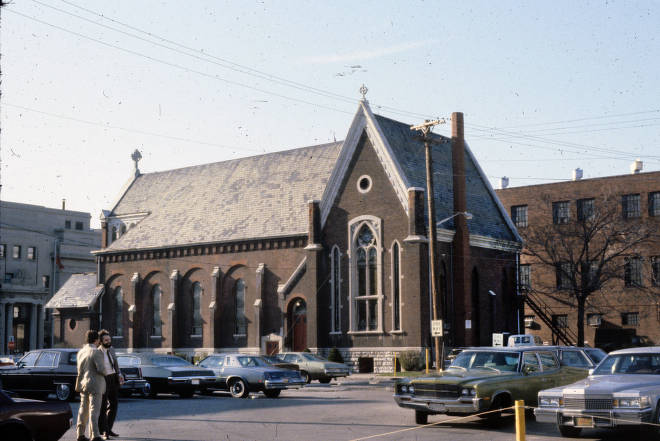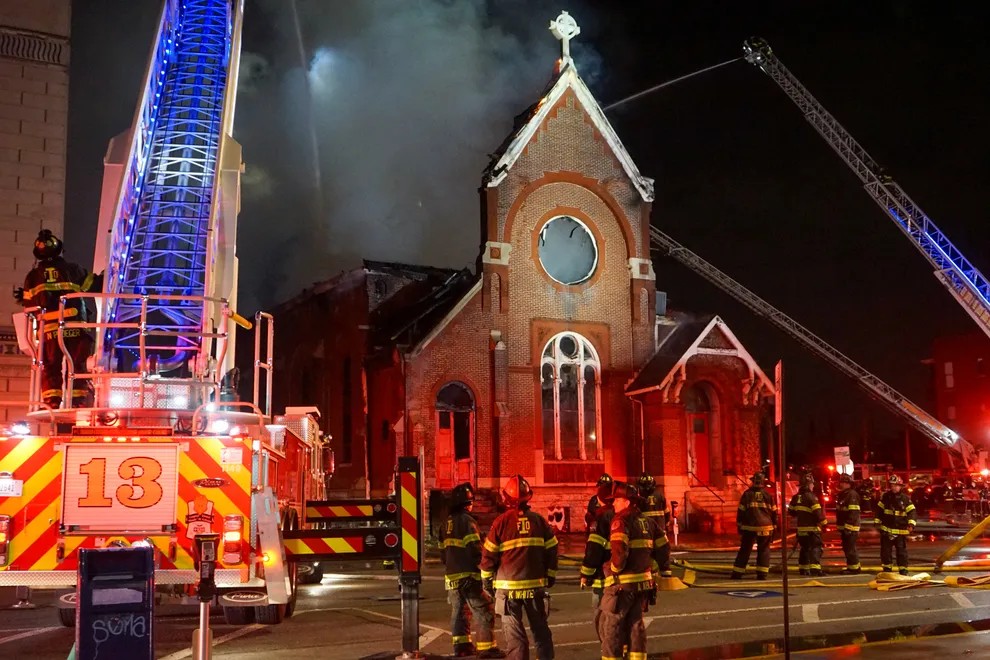Early Indianapolis residents called , a missionary who came to Marion County with a group of Maryland farmers around 1835-1836, to organize the first congregation for that denomination, Mt. Pisgah, in January 1837. The church commonly became known as First Lutheran and First English Lutheran. Reck previously had established Ebenezer Lutheran Church, northeast of Indianapolis in . The congregation, led by men who also had Maryland origins, purchased land near the southeast corner of Meridian and Ohio streets. In 1838 it constructed a one-story brick building. Reck served as first pastor before leaving the area for Cincinnati in 1841.

Under Reck’s guidance, Mt. Pisgah and Ebenezer practiced more liberal liturgical and doctrinal practices than many other Lutherans, affiliating with the governing body, Synod of the West and General Synod. During the 1840s, Mt. Pisgah played an instrumental role in establishing Zion United Church of Christ (1841) and Pleasant View Lutheran Church (1844). In 1846, Mt. Pisgah became the place where Lutherans in the area formed the Olive Branch Synod, a state governing body for Lutheran congregations like Mt. Pisgah.
Around 1860, the congregation tore down its first building and erected a new church on the southwest corner of New York and Alabama streets. In 1874, its members were ready to move again, purchasing a lot at the corner of Pennsylvania and Walnut streets for $2,500. Construction of the third First Lutheran building, which still stands at 701 N. Pennsylvania Street, began in 1874-1875 under the supervision of architect Peter P. Cookingham. Constructed in two sections, it represents two popular religious architectural styles. The first section, a small, late Gothic revival chapel, dates from 1875. It has a high, gabled slate roof, tall, narrow Gothic arched windows, and brick turret buttresses.
The second section, completed in 1886 and built in the Romanesque revival style, became the main sanctuary. It includes a nave with round, arched windows set in arched panels, divided by limestone-capped buttresses. These features are repeated throughout this portion of the building. The two sections connect at the southeast corner of the sanctuary. Both sections perch on raised-limestone foundations.
The congregation made few alterations to the building after 1886. It added a pipe organ on a raised platform behind the altar in 1898 and in 1915 replaced plain glass windows with stained glass. Excavation under the sanctuary, carried out at the same time as the stained-glass installation, allowed for the construction of classrooms and restrooms on a lower level.
First Lutheran’s position immediately outside of the made it a suburban church. In 1920, First Lutheran hosted the Lutheran convention that organized the Indiana Synod, and it hosted the organization’s first administrative offices. As it had in its early history, during the first half of the 20th century, the congregation again played a role in planting other churches, including Gethsemane Lutheran Church (1921), Bethlehem Lutheran Church (1923), and First Latvian Church (1947). The congregation peaked after , when leadership advocated for the rescue of refugees and immigrants, giving rise to contingents of , Lithuanian, and descent. The church even held services in Estonian.
By the 1960s, the tithing population had begun to decline at the same time the maintenance costs for the structure were escalating. Only one man knew how to operate the furnace, and the pronounced fluctuations in temperature accelerated the deterioration of the interior. Despite many challenges, the small congregation remained committed and welcoming to all races and social classes. In 1970, the organized at First Lutheran, exemplifying its commitment to community outreach and development. Its building achieved recognition on the National Register of Historic Places in 1978.
The lack of accessible entrances for an increasingly elderly population curtailed participation by the early 2000s, and the church canceled all Sunday School programs. Yet, its small membership remained true to its commitment to community outreach and development, voicing an interest in reviving the congregation by supporting the constituency of the area surrounding it, especially members of the LGBTQ community. Its efforts, however, proved unsuccessful. In 2002, the Indiana-Kentucky Synod of the Evangelical Lutheran Church in America (ELCA) announced that it was closing the church, shuttering the building two weeks after the announcement. Sunday attendance had dwindled to approximately 30 or 40 individuals.
Within a few years, the local development community indicated interest in converting the structure into condominiums, keeping the shell and repurposing the remaining space for multifamily residences. The owner at the time stripped it of all its carpet and most overt references to religion. But the Great Recession of 2008 decimated the condominium market, leaving First Lutheran in limbo.
J. Scott Wheeler, an events planner, bought the mothballed property in 2011 and rebranded it as a facility for social events. The building’s distinguishing features render it a historically significant example of late-19th-century church architecture. supervised the $400,000 rehabilitation, acknowledging its location within the .
Under its revival as The Sanctuary, the patina of the interior, the central location, and the ecclesiastical appearance helped breathe new life into First Lutheran Church, turning a long-neglected space into an active assembly room for weddings, receptions, banquets, live music/shows, charity fundraisers, and corporate parties. Mark Smith and Roger Reeves took over ownership of the venue circa 2022.

Shortly after 5:30 AM on December 24, 2024, a fire of unknown origin broke out at the venue. First responders could not save the structure which burnt to the ground. By 11 AM demolition of the 184-year-old building started. (See )

Help improve this entry
Contribute information, offer corrections, suggest images.
You can also recommend new entries related to this topic.